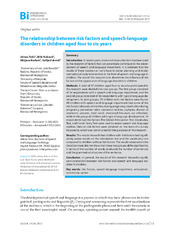Приказ основних података о документу
The relationship between risk factors and speech-language disorders in children aged four to six years
Odnos riziko faktora i govorno-jezičkih poremećaja kod djece uzrasta od četiri do šest godina
| dc.creator | Tešić, Jelena | |
| dc.creator | Vuković, Mile | |
| dc.creator | Korlaet, Milijana | |
| dc.creator | Vuković, Sofija | |
| dc.date.accessioned | 2023-07-31T08:00:35Z | |
| dc.date.available | 2023-07-31T08:00:35Z | |
| dc.date.issued | 2023 | |
| dc.identifier.issn | 2182-1054 | |
| dc.identifier.uri | http://rfasper.fasper.bg.ac.rs/handle/123456789/5184 | |
| dc.description.abstract | Introduction. In recent years, more and more attention has been paid to the research of factors that can potentially contribute to the devel- opment of speech and language impairment. It is believed that the results of these studies can contribute to better planning and imple- mentation of early intervention in the field of speech and language in children. The aim of this research is to determine the influence of risk factors on the appearance of language disorders in children. Methods. A total of 97 children aged four to six who participated in the research were divided into two groups. The first group consisted of 54 respondents with a speech and language impairment, and the second group consisted of 43 respondents with typical language de- velopment. In both groups, 70 children with risk factors were found. All children with speech and language impairment had some of the risk factors (diseases of mothers during pregnancy, medication during pregnancy, premature labor, caesarean section, asphyxia, disease of newborns, seizures, third tonsil, shortened frenulum, ear infection), while in the group of children with typical language development, 16 respondents had risk factors. The Global Articulation Test, Vocabulary Test, and Comic Story Test were used to assess speech and language abilities. Data on risk factors were obtained on the basis of a survey for parents, which was constructed for the purposes of this research. Results. The results showed that children with risk factors had signifi- cantly worse results on the articulation test and the vocabulary test compared to children without risk factors. The results obtained on the Strip Story test did not show that these two groups differ significantly in terms of the number of words produced, the number of sentences and the grammatical structure of the sentence. Conclusion. In general, the results of this research showed a signifi- cant connection between risk factors and speech and language dis- order in children. | sr |
| dc.description.abstract | Uvod. Posljednjih godina se sve više pažnje posvećuje istraživanju faktora koji potencijalno mogu doprinijeti poremećaju razvoja govora i jezika. Smatra se da rezultati ovih istraživanja mogu pomoći boljem planiranju i sprovođenju rane intervencije u oblasti govora i jezika kod djece. Cilj ovog istra- živanja je utvrđivanje uticaja riziko faktora na pojavu jezičkih poremećaja kod djece. Metode. U istraživanju je učestvovalo 97 djece uzrasta od četiri do šest godina, koja su podijeljena u dvije grupe. Prvu grupu činilo je 54 ispitanika sa poremećajem u govorno- jezičkom razvoju, a drugu 43 ispitanika tipičnog jezičkog razvoja. U obje grupe pronađeno je 70 djece koja imaju riziko faktore. Sva djeca sa poremećajem u govorno-jezičkom razvoju imala su neki od riziko faktora (oboljenja majki u trudnoći, kao i lijekovi koje su majke pile u toku trudnoće, prematurus, carski rez, asfiksija, bolest novorođenčadi, epileptični napadi, treći krajnik, skraćen frenulum, upala uha), dok je u grupi djece tipičnog jezičkog razvoja 16 ispitanika imalo riziko faktore. Za procjenu govorno-jezičkih spo- sobnosti korišćeni su Globalni artikulacioni test, Test-rječnik i test Strip priča. Podaci o riziko faktori- ma dobijeni su na osnovu ankete za roditelje koja je konstruisana za potrebe ovog istraživanja. Rezultati. Rezultati su pokazali da djeca sa riziko faktorima imaju značajno lošije rezultate na testu artikulacije i testu rječnika u poređenju sa djecom bez podataka o riziko faktorima. Rezultati dobijeni na testu Strip priča nisu pokazali da se ove dvije grupe statistički značajno razlikuju u pogledu broja produkovanih riječi, broja rečenica i gramatičkoj strukturi rečenice. Zaključak. Generalno gledano, rezultati ovog istraživanja pokazali su da postoji značajna poveza- nost između riziko faktora i smetnji u razvoju govorno-jezičkih sposobnosti kod djece. | sr |
| dc.language.iso | en | sr |
| dc.publisher | Univerzitet u Beogradu – Fakultet za specijalnu edukaciju i rehabilitaciju/ University of Belgrade – Faculty of Special Education and Rehabilitation | sr |
| dc.rights | openAccess | sr |
| dc.rights.uri | https://creativecommons.org/licenses/by/4.0/ | |
| dc.source | Biomedicinska istraživanja | sr |
| dc.subject | risk factors | sr |
| dc.subject | speech-language impairment | sr |
| dc.subject | articulation | sr |
| dc.subject | vocabulary, syntax | sr |
| dc.subject | riziko faktori | sr |
| dc.subject | govorno-jezički poremećaji | sr |
| dc.subject | artikulacija | sr |
| dc.subject | rječnik | sr |
| dc.subject | sintaksa | sr |
| dc.title | The relationship between risk factors and speech-language disorders in children aged four to six years | sr |
| dc.title | Odnos riziko faktora i govorno-jezičkih poremećaja kod djece uzrasta od četiri do šest godina | sr |
| dc.type | article | sr |
| dc.rights.license | BY | sr |
| dc.citation.epage | 63 | |
| dc.citation.issue | 1 | |
| dc.citation.volume | 14 | |
| dc.citation.volume | 53 | |
| dc.identifier.doi | 10.59137/BII202301301T | |
| dc.identifier.fulltext | http://rfasper.fasper.bg.ac.rs/bitstream/id/10491/bitstream_10491.pdf | |
| dc.type.version | publishedVersion | sr |


